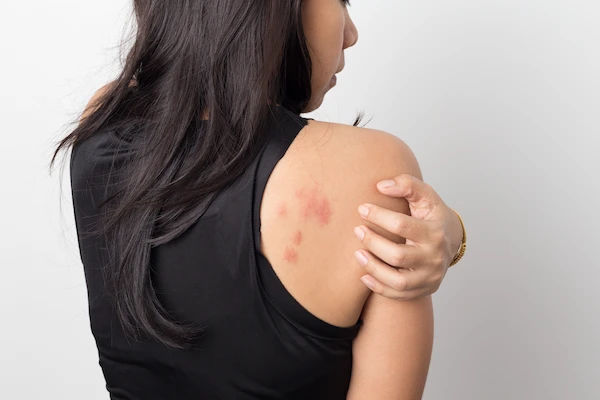How To Reduce Sebum Production Internally: Dietary Interventions and Stress Management
A high level of sebum can damage one's skin with acne and other issues. Learn about the causes of excessive sebum production, its effects and internal treatment methods.

Written by
Last updated on 3rd Jul, 2025
Sebum is the oil secretion on the skin surface, especially the face. It is a complex and variable mixture of wax esters, free fatty acids, cholesterol, glycerides, squalene, etc., produced by the sebaceous glands in the skin. Sebum acts as a protective layer on the face, keeps the skin hydrated, and prevents it from external damage.
However, over-secretion and under-secretion of sebum leads to many more problems such as acne, oily skin, irritation, dryness, etc. Therefore, a balance is necessary to be maintained to ensure the health of the skin. The causes and effects of high secretion and the ways to control the condition are discussed below to help individuals keep a check on the sebum levels!
Causes of Excessive Sebum Production
Here are some of the reasons why sebum is produced at higher levels:
Hormonal Influences
A woman undergoes hormonal changes in her pregnancy, menopause, puberty, and menstruation. This hormonal level fluctuation can increase the sebum production level on a person's face. Sebaceous glands, which are found at the second layer of one's skin, produce more oil after being stimulated by testosterone and androgens. Teenagers have high levels of androgens during their puberty, which causes more sebum and oily acne-prone skin. Women also face hormonal imbalance during menstruation, leading to excessive sebum production.
Diet and Nutrition
Eating habits affect how much oil an individual produces in their skin. When one feeds on foods highly rich in sugars, refined carbs, and also dairy products, the production of sebum accelerates. An increase in dietary insulin level sets off hormonal fluctuations, mainly stimulating the growth of oil glands and thus further increasing sebum.
Stress and Lifestyle Factors
Stress can significantly influence sebum production. High-stress levels can disrupt hormone balance and increase inflammation, leading to overactive sebaceous glands. Modern lifestyles often subject the body to constant stress, which can aggravate skin issues like acne and oily skin.
Dietary Interventions to Manage Sebum Levels
Skin health is affected by the foods one eats. Some dietary interventions can control sebum production in the skin.
Foods to Avoid
Foods that include high saturated fats or disrupt one's blood sugar level should be avoided to reduce sebum production. Foods, including added sugar, refined carbohydrates, fruit juices, dairy products, etc., increase insulin levels and sebaceous gland stimulation. Thus, one should avoid these foods to reduce sebum production. Also, one should lower the consumption of glycemic-containing foods and avoid alcohol to manage sebum production.
Foods that Promote Healthy Skin
Including some foods in a regular diet can help manage sebum production. Including foods rich in healthy fats, zinc, vitamins, etc., can help improve one's skin health. Omega-3 is a good source of healthy fats that help limit the excessive secretion of the sebaceous gland.
Role of Hydration
Keeping one's skin hydrated is equally important to check the sebum level. Lack of water can stimulate the oil glands to produce more sebum. Thus, drinking enough water to stay hydrated throughout the day is necessary.
Hormonal Management to Check Sebum Levels
Sebum production is related to testosterone hormone levels in one's body. Individuals taking supplements to increase their testosterone levels or doing rigorous workout sessions may experience a spike in sebum production.
Therefore, one should control testosterone production to reduce sebum stimulation. Here are some medicines that help reduce the testosterone levels:
Spironolactone
Cyproterone
Propecia or any other 5-alpha reductase inhibitor medicines
Antiandrogens are also effective in lowering sebum levels
Natural supplements like fatty acids, fibres, and omega-3 can also help in controlling the testosterone levels
Importance of Nutritional Supplements
Individuals facing issues with excessive sebum production can intake nutritional supplements to regulate the stimulation. Here are some of them:
Omega-3 Fatty Acids
The role of omega-3 in improving skin health deserves mention. Nuts, fatty fish, and seeds are rich in omega-3, a nutrient with high anti-inflammatory properties. It can control the over-secretion of sebaceous glands, reducing sebum levels and inflammation.
Zinc and its Benefits
Minerals like zinc provide healthy skin by controlling sebum production and reducing acne. One can intake zinc-rich foods such as legumes, nuts, whole grains, and oysters to minimise inflammation and check the sebum levels. Zinc can also be used in beauty products to control the sebum production. For instance, Zinc PCA in moisturisers helps mattify the skin by reducing sebum levels.
Role of Vitamin A and E
Consuming vitamin A supplements like retinoids can control the sebum production. As per studies, an increase of vitamin A level by 4.8% in a body through dietary sources can decrease sebum production by 1.4%. Foods like kale, broccoli, carrots, spinach, milk, eggs, mango, etc., are rich sources of vitamin A.
Role of Skincare Routine in Sebum Regulation
Besides the nutritional supplements and dietary changes, one can also regulate the sebum level through proper skincare.
Benefits of Gentle Cleansing
Clean skin can regulate the oil secretion and maintain skin health. So, one should wash their face at least twice daily in the morning and evening. Using non-soap, pH-balanced, and gentle face washes can help avoid extra oil secretion and keep the skin clear and healthy.
Importance of Non-Comedogenic Products
Non-comedogenic products are made of ingredients that do not block or clog the pores of one's skin, helping reduce the oil production and risks of acne. Individuals who have oily skin are likely to produce excessive sebum. Using non-comedogenic beauty products helps them regulate sebum production. Tea tree oil, salicylic acids, etc., are used in gentle skin cleansers to control excessive oil. They clean the skin but do not leave the skin excessively dry.
Consult Top Dermatologist
Lifestyle Changes to Support Sebum Reduction
Skin problems like oily skin, acne, etc., are also triggered by stress and unhealthy lifestyle. Regular exercise and healthy stress management techniques can control sebum production.
Impact of Regular Exercise
Physical activities help release endorphins in one’s blood, improving mood. A calm body and mind can maintain hormonal balance and reduce the sebum level. However, one should avoid rigorous workouts as they cause sweat and block the skin pores, leading to acne and oil secretion. Individuals who are doing desk jobs can walk around from time to time for light physical activity.
Stress-Reduction Techniques
Keeping the hormones balanced helps control the sebum production in one's skin. Stress management techniques allow one's mind to relax, keep the stress hormone levels low, and maintain healthy sebum levels.
One can do meditation, yoga, and practice breathing techniques to manage stress hormones.
Individuals can also opt for periodic therapeutic massage to reduce cortisol levels. This can help relieve the tense muscles and calm one's body and mind.
Apart from these, getting a restful sleep for at least 7 to 8 hours every night is essential. Insufficient sleep can increase inflammation and affect the hormone balance.
Monitoring and Adjusting Your Approach
Here’s how you can monitor your approach to reduce sebum production:
Keeping track of changes in your skin’s condition can help you assess the effectiveness of your sebum reduction strategies.
Note down any improvements or worsening of oiliness, acne breakouts, or skin irritation.
Consulting with healthcare professionals, such as dermatologists or endocrinologists, can provide personalised recommendations and medical treatments for managing sebum production.
Doctors may recommend topical or oral antibiotics, retinoids, hormone therapy, corticosteroids, light therapy, or chemical peels to address severe cases of oily skin.
Conclusion
Sebum productions can be managed internally, but the procedure is comprehensive and requires a consistent approach. From dietary interventions to stress management schedules, everything should be on point to ensure balanced sebum levels in an individual. One should follow the mentioned guidelines to check sebum production and get healthy, glowing skin.
Consult Top Dermatologist
Consult Top Dermatologist
Dr. Kavitha Killaparthy
Dermatologist
23 Years • MBBS,DIPLOMA(DERMATOLOGY,VENEREOLOGY,LEPROSY)
Hyderabad
JDS Skin & Hair Clinic, Hyderabad
Dr. Mayuri Jain
Dermatologist
11 Years • MBBS, MD Dermatology , Venereology & Leprosy
Delhi
Dr Mayuri Jain Clinic, Delhi

Dr. Madhab Datta
Dermatologist
5 Years • MBBS, MD (DVL)
Kolkata
Dr. Madhab Datta's Clinic, Kolkata
Dr.j Girishma
Dermatologist
6 Years • MBBS MD DERMATOLOGY
Bengaluru
Apollo Medical Center, Marathahalli, Bengaluru

Dr. Ashwini T
Dermatologist
8 Years • MBBS, MD ( DERMATOLOGY )
Bengaluru
Apollo Clinic, JP nagar, Bengaluru
Consult Top Dermatologist
Dr. Kavitha Killaparthy
Dermatologist
23 Years • MBBS,DIPLOMA(DERMATOLOGY,VENEREOLOGY,LEPROSY)
Hyderabad
JDS Skin & Hair Clinic, Hyderabad
Dr. Mayuri Jain
Dermatologist
11 Years • MBBS, MD Dermatology , Venereology & Leprosy
Delhi
Dr Mayuri Jain Clinic, Delhi

Dr. Madhab Datta
Dermatologist
5 Years • MBBS, MD (DVL)
Kolkata
Dr. Madhab Datta's Clinic, Kolkata
Dr.j Girishma
Dermatologist
6 Years • MBBS MD DERMATOLOGY
Bengaluru
Apollo Medical Center, Marathahalli, Bengaluru

Dr. Ashwini T
Dermatologist
8 Years • MBBS, MD ( DERMATOLOGY )
Bengaluru
Apollo Clinic, JP nagar, Bengaluru


